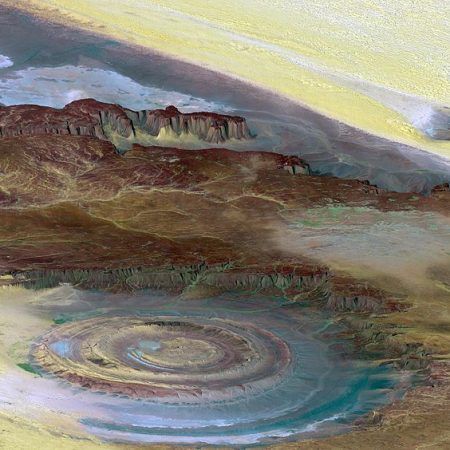The Sahara desert is the biggest sand desert in the world. It stretches across about 1/3 of continental Africa, covering the entire regions of Northern Africa. There is ample evidence that The Sahara is still expanding – by as much as an estimated 10% in the last 100 years or so.
So it has always been a mystery to me why we don’t teach the history of the Sahara as part of the history curriculum in our schools. I recently decided to hit the history section of my local library to follow up on this matter. After months of online research, I wanted to see what the history books say about African history in general.
In “The Third World”, a book by Daily Nation columnist William Robert Ochieng’, I got to read the accepted version of the histories of some East African peoples. But without factoring in the impact of Sahara desert expansion on African populations, the book read more like speculative non-fiction than a historical account.
The ambiguous origins of the Bantus
So, to refresh my high school history lessons, I picked up the history textbooks for forms 1 to 4. There was still no mention of Sahara desert expansion and the impact it had on the continent. In near-perfect unison, all books give the same vague northern locations.
As a high school student, this logical gap did not register. I didn’t question this simplistic explanation for my origins. And when I did start, I was discouraged by authors who stated, with absolute certainty, that it is impossible to tell with certainty from whence the Bantu expansion originated.
However, with a little extra effort, a good deal of research, and a good dose of intuition, I have found that this could not be further from the truth; unless you restrict your study of history to human history and the history of the earth (Geography) to earth history. However, when you merge the two disciplines, a very different picture emerges.
The lost city of Atlantis
Many people have heard of the mysterious lost city of Atlantis. It is mentioned in Plato’s Critias dialogue, sung about by Alan Walker, dramatized in several movies and series, and widely searched for by explorers and historians alike. More and more, it is starting to seem like we might have the definitive answer as to where exactly this majestic city might have been located, who built it, and why it collapsed.
In Critias, Plato relates the findings of a Greek historian named Strobo when he visited Egypt in the 6th century BC. From Solon’s report, Atlantis was lost to the sea in a single day of calamity and great destruction.
But this vague explanation raises more questions than it answers. Or have we just been looking at this whole thing the wrong way?
In this essay, I will try to prove that Atlantis was an actual civilization. It may not necessarily have been restricted to the circular water-surrounded city in The Eye of Africa as described by Plato in great detail. Strabo gives the date of Atlantis’ destruction to have been about 11,000 years ago. I believe the number is much closer to 5,500 years – the date of the last Earth Wobble.
Changing geography
Today, we know that the earth is not static. The continental plates shift and move, and that is how we get earthquakes, tsunamis, volcanic eruptions, the rift valley, among other features and incidences. However, nothing could be as disruptive as the sudden tilting of the earth’s axis, as happens during an Earth Wobble.
So far, I haven’t found any descriptions of what takes place during an Earth Wobble. However, I envisage a situation in which massive earth movements occur. These movements could easily have caused the destruction that marked the beginning of the desertification of the Sahara.
If the Sahara has been expanding in the last 100 years, it has probably been expanding for the 100 years before that, and the 100 years before that. If indeed it was born after the Earth Wobble 5,500 years ago, then it follows that the desert has been expanding for much longer. It is therefore not amiss to postulate that the massive Sahara of the 21st century started from a much smaller patch of arid land 5,500 years ago.
In every history book on the subject, the Bantu are said to have moved from the “North” to escape drought and famine. Let me be the first to suggest that the Bantus moved from Northern African territories to escape from the recently formed (at the time) and expanding Sahara.
The Sahara Pump theory
The Sahara Pump theory is an idea that postulates a Green Saharan recent cradle of many modern civilizations. When the sun started beating longer, the wind blew stronger, and the rain fell more and more sparsely, people were forced to move out in masses.
From the similarities between their spiritual motifs, I draw a link between the Biblical Jews and Sub-Saharan Bantus in Green Sahara over 5,000 years ago. The former moved East and got caught up in pharaonic Egypt, while the latter moved South, only to be forced to move again when the ever-expanding Sahara caught up with them centuries or millennia later.
But when the land of Atlantis became hot and dusty, the former settlers of Green Sahara moved in every direction. In Southern Europe, numerous excavations have revealed civilizations similar to those observed inside the Sahara. The remnants – those who were left behind to eke out a living among the dunes and the oasis – are now so different as to not be recognized as relatives of the native settlers of Green Sahara.
Africa-wide disruptions of desertification
Even today, millions of acres of land are becoming arid. The United Nations has identified desertification as the biggest threat to world stability today. There is no reason to expect the situation to have been any different back when the Sahara Desert started.
Watching Atlantis the series, I was struck by how frightening and disruptive the switch to aridity must have been. The people must have been terrified! “We have wronged the gods” they would say. “It will all go back to the way it used to be.” They’d console themselves.
Of course, the series got the location and colour of actors all wrong – as usual – but this doesn’t make it any less accurate in depicting the chaos therein. It would have been a painful process to get to the ultimate acceptance of the fact that to survive they’d have to seek new homes elsewhere.
Land of Atlantis
History buffs place the city of Atlantis, speculatively, in The Eye of Africa. It is shielded to the North by the Atlas Mountains and surrounded by dried-up lakes and rivers. So Atlantis was less of a city-state and more of a civilization. With massive lakes to draw water from, Atlantis would have been an expansive region that hosted a diverse group of unified or unrelated people.
The location of The Eye of Africa makes it the perfect city to control the Western regions of Northern Africa while Egypt dominated in the East. Many more nations spread along the massive territories now occupied by desert sand.
When the region started drying up, only non-agriculturalists could afford to hang around. And even then, only the best fighters could defend their diminishing resources from their neighbours effectively. In the case of Green Sahara, the Phoenicians and the ancestors of the Berbers survived (even thrived) in the desert.
Sea of sand
In a few centuries to a few millennia, most of the former empires of Green Sahara would have been scattered near and far. However, as with any mass transition of clans and families, the movement occurred in waves. In 1200 BC, continued fighting for territory (and possible expansion of the Sahara) culminates in the Late Bronze Age Collapse attack of the sea peoples.
The massive destruction of the former homeland leaves the memory of Atlantis only in myth and fables. Save for a few rock paintings and fossilized remains, hardly anyone would believe that the sea referred to in all stories relating to Atlantis is indeed the sea of sand.
The Late Bronze Age collapse
Today, we know of the Sea Peoples – the coalition of tribes that tried to invade ancient Egypt and other regions of the East Mediterranean during the Late Bronze Age collapse – from hieroglyphic records. So you can imagine my surprise when I learned that “utu”, that distinctly “Bantu” concept of being, is shared by the ancient northernmost people of Africa – the Phoenicians.
This is the best proof I have so far that ancient Bantus shared a home (as well as beliefs, culture, and maybe language) with ancient Saharan people. Given all this evidence, I postulate that Akhenaten’s unpopular religious reforms of the 14th century BC had been in response to the humanitarian crisis caused by the expanding Sahara.
In the invasion of The Sea Peoples, the newcomers are captioned carrying their possessions and moving in families. This was very possibly the world’s first refugee crisis. Could a new wave of expansion of the Sahara have caused the mass transit? In my preliminary research, I have established that those who went via Egypt could be the Eastern Bantus who arrived in East Africa long after the Western branch came in via The Congo Forest.
Also read: The Common Divergence of African Peoples: The Late Bronze Age Collapse
Assimilation
The Kikuyu easily assimilated into the Pygmy and Okiek communities they found living around Mt. Kenya. A shared sense of loss could explain the relatively peaceful manner in which this happened. Even if some used force, a good portion of former Atlantians were simply searching for new land to cultivate. If they came to dominate later on, it would only be after many years of population expansion.
Aside from high birth rates, new waves of people continued to arrive, with one outstanding route being from Egypt through Ethiopia. These are the ones who brought stories of Abyssinia, Egypt, and the wild Levant. They also interacted with many native Egyptians who would later move south after the collapse of the black Pharaonic dynasty there.
And when the Maasai started arriving in Kenya in 16th and 17th centuries, they formed an alliance with the Agikuyu almost automatically. The latter used the military might of Maasai Morans to secure their claim to the Kenyan highlands while the Maasai got to maintain their militaristic lifestyle.
The evidence for a Northern African origin of African Bantus is overwhelming. That Green Sahara is also the mystical land of Atlantis is subject to more debate. But it is a debate that we need to be leading.
In Faded, Alan Walker sings;
Atlantis, under the sea
Where are you now?
Finally, a conclusive answer: all over the place, Alan!





